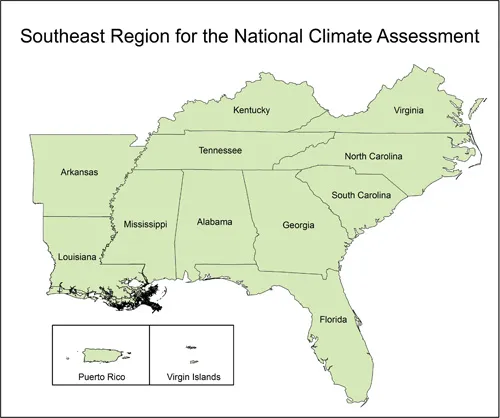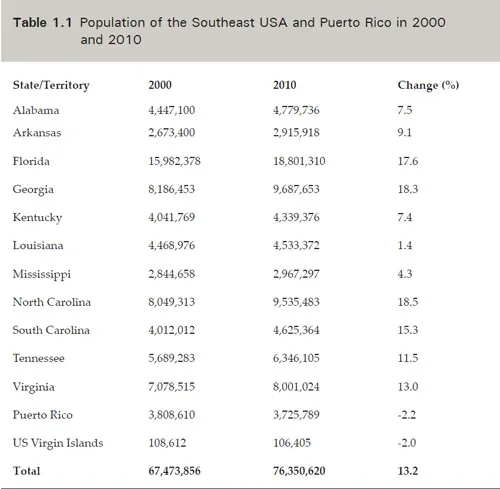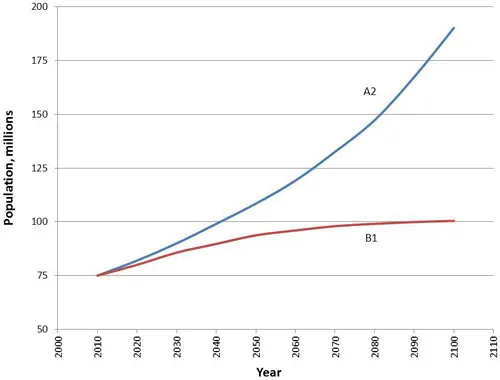![]()
Chapter 1
Climate Change in the Southeast USA: Executive Summary
LEAD AUTHORS
CONTRIBUTING AUTHORS
This book is based on a technical report the National Climate Assessment (NCA) document that was prepared for submission to the President of the United States and the United States Congress. That document summarized the scientific literature with respect to climate impacts on the Southeast (SE) USA, in particular the literature that has been published since 2004. A national assessment was produced in 2009; however, no technical report was developed in support of that document.
For the Third US National Climate Assessment, the Southeast region includes 11 southern states (Figure 1.1), Puerto Rico, and the US Virgin Islands. This region differs slightly from the previous National Climate Assessment in that it follows state borders and does not include the Gulf Coast of Texas.
Figure 1.1 Map of the states in the Southeast region for the US National Climate Assessment. Note that the region and report also covers Puerto Rico and the US Virgin Islands.
1.1 Diversity and Vulnerabilities
The SE USA is characterized by great diversity in terms of climate, natural and managed ecosystems, social and political attitudes, and vulnerabilities. While most of the SE is classified as humid, temperatures vary widely across the regions, with a transition from tropical rainforests in Puerto Rico and the US Virgin Islands to temperate forests in the southern Appalachian Mountains. This climatic diversity, which is described in detail in Chapter 2, results from a range of weather patterns that affect the region, including frontal systems that dominate during fall and winter, convective systems that dominate during the spring and summer, tropical systems that are important during the summer and fall, and sea breeze systems that are important for the coastal regions. In addition, the region is prone to other extreme weather phenomena, including droughts, floods, winter storms, and tornadoes.
The region also is subject to related risks that interact with climate variability and change. For example, sea level change and salt water intrusion already threaten many coastal communities (Chapter 5) and ecosystems (Chapters 9 and 11). Sea level change, which includes both sea level rise and land subsidence in parts of Louisiana, Mississippi, and Alabama, makes the region more vulnerable to storm surges produced by tropical storms or winter storms in the Gulf of Mexico (Mitchum 2011). Increasing atmospheric carbon dioxide concentrations might benefit agricultural (Chapter 7) and forest systems (Chapter 8) of the region through increasing photosynthesis, but benefits are likely to be offset by losses of productivity that would result from increased temperatures. Increasing atmospheric carbon dioxide concentrations are also projected to acidify surface waters, which would likely inhibit the growth of corals, shellfish, and crustaceans (Chapter 9). Finally, increasing atmospheric carbon dioxide increases pollen production by many plant species, which has been linked with increased levels of asthma and respiratory illnesses (Chapters 3 and 7).
Climate also interacts with social conditions in the Southeast, which has experienced unprecedented population growth during recent decades. All states in the region had positive growth from 2000 through 2010, with overall population growing by 8.9 million people, or about 13% (Table 1.1). Population grew the most in North Carolina (18.5%), Georgia (18.3%), Florida (17.6%), and South Carolina (15.3%), and most of that population growth has been in urban and peri-urban areas (Mackun and Wilson 2011). In the region, only Puerto Rico and the Virgin Islands had negative growth (- 2.2 and -2 percent respectively) (Mackun and Wilson 2011). States with the fastest growing populations on a percentage basis were mostly states that already had relatively large populations. This trend indicates widening differences in population density among states in the Southeast. Population growth likely will compound climate related risks for most sectors. Increasing competition for water resources (Chapter 10) will likely affect the energy (Chapter 4), agriculture (Chapter 7), fisheries and aquaculture (Chapter 9), natural ecosystems (Chapter 11), and built environment (Chapter 5) sectors.
The diversity of people, natural and managed ecosystems, and resources of the Southeast provide the region with great richness. With coastlines along the Gulf of Mexico and South Atlantic seaboard, the SE has a wealth of estuaries (Chapter 12) with associated fishing industry (Chapter 9), ports with associated transportation hubs (Chapter 6), and beaches with associated tourism (Chapter 13). Inland forests constitute an important carbon sink (Chapter 8), which mitigate greenhouse gas effects on climate (Chapter 12). Its relatively humid, high rainfall environment provides the SE sufficient water resources (Chapter 10) to be a major exporter of energy (Chapter 4) to other regions at present, though future increases in competition for water resources might diminish the region’s energy production capacity. Climate change threatens all of these natural resources and the industries that depend on them. Thus, it is not surprising that there are numerous efforts already underway in the SE to mitigate and adapt to climate change (Chapters 12 and 13). In addition there are ongoing programs to educate people about climate variability, climate change, and ways society can manage climate related risks (Chapter 14).
Source: Mackun and Wilson 2011, US Census Bureau 2000a, US Census Bureau 2000b, US Census Bureau 2010a, US Census Bureau 2010b.
1.2 Time-scales of Interest to Southeast Decision Makers
Decision makers in the SE have the greatest interest in seasonal and decadal timescales (Bartels et al. 2011). Typically, the time-scale of interest matches the time-scale of investments and expenditures, most of which are 20 years or less. In order to engage decision makers in the use of climate information, it is important to provide information at time-scales that are relevant to the decisions for which they need information. If the science community can provide useful information at these shorter timescales, as decision makers use that information to manage seasonal and near term climate risks, they also begin to adapt to and mitigate climate change (Fraisse et al. 2009).
An advantage to providing climate information at shorter time-scales in the SE is that seasonal climates of the Florida peninsula and coastal plains from Louisiana to North Carolina are affected by sea surface temperatures in the equatorial Pacific, or El Niño-Southern Oscillation phenomenon (Chapter 2). For these areas, El Niño conditions typically result in cool, wet fall and winter conditions whereas La Niña conditions typically result in dry, warm fall and winter conditions. To the north of the coastal plains, seasonal climate does not typically exhibit an El Niño-Southern Oscillation signal.
1.3 Future Scenarios
In this report, we use the term “projection” to describe how future climate is expected to respond to various scenarios of population growth, greenhouse gas emissions, land development patterns, and other factors that might affect climate change. The report uses two of the Intergovernmental Panel on Climate Change (IPCC) scenarios for climate projections, A2 and B1. It is important to recognize that these scenarios describe potential situations for both greenhouse gas (GHG) emissions and societal development alternatives.
The A2 scenario is the most pessimistic in that it assumes that nations will have little or no response to anticipated adverse effects of climate change (EPA 2012). The A2 storyline and scenario describes a heterogeneous world with an underlying theme of self-reliance and preservation of local identities. Birth rates across regions converge slowly, which results in continuously increasing population. This scenario is often called “business as usual.”
The B1 storyline and scenario describes a convergent world with the same global population as in the A1 storyline, but with rapid change in economic structures toward a service and information economy (EPA 2012). This scenario includes a reduction in material intensity and the introduction of clean and resource-efficient technologies. It emphasizes global solutions to economic, social, and environmental sustainability, including improved equity, but without additional climate initiatives. The B1 scenario is the most optimistic in that it generally reflects a concerted, global effort to mitigate human impacts that would further warm the planet.
An important feature of these scenarios is the difference in population growth for the region (Figure 1.2). In the A2 scenario the population of the SE nearly triples from 2010 through 2100 whereas in the B1 scenario, population increases about one-third over the same period. If population growth follows trends similar to those simulated in the A2 scenario, the SE will experience far more cross-sectoral competition for land and water resources, which will compound climate change impacts. On the other hand, the B1 scenario with its more modest population growth provides more opportunities for adaptation and mitigation.
Another important factor for the SE will be changes in land use and land cover. As population grows, development is inevitable. How that development proceeds, however, will have great impact on regional climate (Shin and Baigorria 2012).
Figure 1.2 Population projections for the Southeast USA for the A2 (greatest climate change) and B1 (least climate change) scenarios.
1.4 Process for Developing this Book
This document has been produced through collaboration among three Regional Integrated Sciences and Assessments Centers (RISAs): the Southeast Climate Consortium; the Carolinas Regional Sciences and Assessments; and the Southern Climate Impacts Planning Program; and with contributions from numerous local, state, federal, and non-governmental individuals and agencies. We established a leadership committee that was charged with the design of the overall report and the organization of a two-day workshop with about 90 participants that was held in Atlanta, GA, in September 2011. From September 2011 through February 2012, more than 100 contributors provided information to lead authors, who drafted the chapters, which were reviewed and revised to the extent possible given the time...



